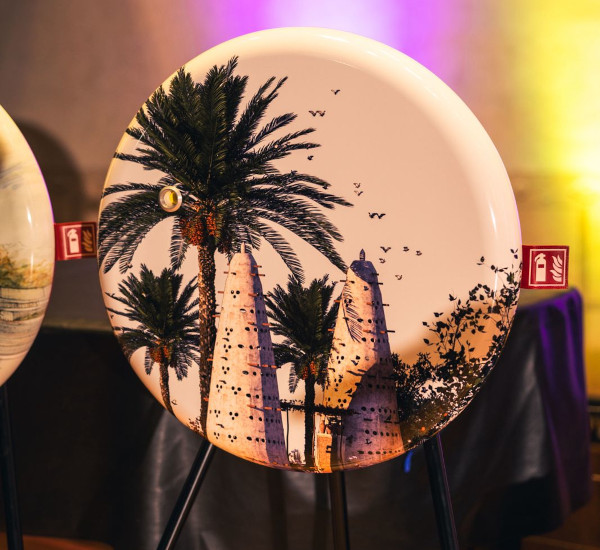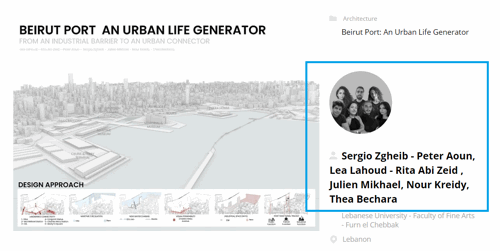JURY
Become a member of the world's biggest jury in history of architecture & help us to support students.
There are 1720 jurors from 134 countries. The voting will take place online once a year - there are 2 rounds and each gives you a week to place your votes.
Write the most feedback for the current year of the competition and win a prize in the form of your own shield with your own design!
Total of 2694 projects received the feedbacks written by 551 jurors.
Voting System
Time Schedule
October 1, 2025
Start of signing up for the competition
June 15, 2026
Termination of registration for the competition
June 17-23, 2026
Voting in the semifinals
June 26 - July 7
Voting in the finals
June 26, 2026
Announcement of finalists
Autumn 2026
Announcement of the winners

Give your feedbacks to be rewarded at 11th INSPIRELI AWARDS until:
AWARDED GLOBAL STUDENT MENTORS for 10th year of competition
INSPIRELI JURY FEEDBACK
This professional dedicated his time and expertise to these students and their projects.

Ionela Tertis
UAUIM - Ion Mincu University of Architecture and Urban Planning, Romania

Marek Juhás
Faculty of Architecture and Design STU in Bratislava, Slovakia

Dariia Telesniuk
Faculty of Architecture and Design STU in Bratislava, Ukraine

Dea Veseli
University of Prishtina, Kosovo

Vadim Bobukh
Saint-Petersburg Mining University, Russian Federation

Florian Anschober
University of Innsbruck, Fakultät für Architektur, Innsbruck, Austria

Patrícia Ptáčková
FAST VUT - Faculty of Civil Engineering, Brno University of Technology, Department of Architecture, Czech Republic
INSPIRELI JURY FEEDBACK
This professional dedicated his time and expertise to these students and their projects.
INSPIRELI JURY FEEDBACK
This professional dedicated his time and expertise to these students and their projects.

Anna Elisa Panzer
Bauhaus University (BUW), Faculty of Architecture, Weimar, Germany, Germany

Abdul Mateen
American University of Sharjah, College of Architecture, art and Design, Sharjah, United Arab Emirates

ahamed dhilzath
University of Moratuwa (UoM), Faculty of Architecture, Department of Architecture, Moratuwa, Sri Lanka

DRIDI IHEB
École Nationale d'Architecture et d'Urbanisme (ENAU) Tunis, Tunisia
INSPIRELI JURY FEEDBACK
This professional dedicated his time and expertise to these students and their projects.

Sera İpekçioğlu
Berlin International Univeristy of Applied Sciences, Germany

Orekhina Alena
Yaroslavl State Technical University, Russian Federation

anmar AL-Qarni
Umm AL-Qura university, Saudi Arabia

Abdulaziz Al-Nesayan
Qassim University, Saudi Arabia

Jakub Černík
CTU in Prague - Faculty of Civil Engineering, Czech Republic

Klára Pořízková
CTU in Prague - Faculty of Civil Engineering, Czech Republic

Khaled Alghamdi
Umm AL-Qura university, Saudi Arabia

Karin Molinková
CTU in Prague - Faculty of Civil Engineering, Czech Republic

Dominika Wcisło
Cracow Technical University (Politechnika Krakowska), Kraków, Poland

ondrej kovac
Faculty of Architecture and Design STU in Bratislava, Slovakia

Emilia Luty
Poznań University of Technology (Politechnika Poznańska), Faculty of Architecture, Poznań, Poland

Adam Chudík
Faculty of Architecture and Design STU in Bratislava, Slovakia

Mária Bogárová
Faculty of Architecture and Design STU in Bratislava, Slovakia

Julia Moskvina
Nizhny Novgorod State University of Architecture and Civil Engineering (NNGASU), Russian Federation

Tereza Floriánová
FAST VUT - Faculty of Civil Engineering, Brno University of Technology, Department of Architecture, Czech Republic

Diana Petukhova
NSUADA - Novosibirsk State University of Architecture, Design and Arts, Russian Federation

Christopher Hamjaya
UNPAR, Indonesia

Alicja Szedel
Silesian University of Technology, (Politechnika Śląska), Faculty of Architecture, Gliwice, Poland

Maria Gromova
Yaroslavl State Technical University, Russian Federation

ROWIDA KHALID
Faculty of Fine Arts, Alexandria University in Alexandria, Egypt
INSPIRELI JURY FEEDBACK
This professional dedicated his time and expertise to these students and their projects.

Daria Telegina
Ural State University of Architecture and Art, Russian Federation

RIME NECHADI
Final international university, Morocco

Diana Petukhova
NSUADA - Novosibirsk State University of Architecture, Design and Arts, Russian Federation

Suzan Al sofi
Sana'a University, Yemen

Mahsa Mohebbi
IAUCTB, Islamic Republic of Iran

Karim Enany
Faculty of Fine Arts, Alexandria University in Alexandria, Egypt

Dena Hassan
Cairo University, Faculty of Engineering Architecture Department., Egypt

Kenza Kettani
Université international de rabat UIR, Morocco

Sondos Abozeid
Faculty of Fine Arts, Alexandria University in Alexandria, Egypt

Tihon Belskih
Moscow State University of Geodesy and Cartography , Russian Federation

Anisa Menxhiqi
University of Prishtina, Kosovo

Abdulaziz Al-Nesayan
Qassim University, Saudi Arabia

Salma Amr
Cairo University, Faculty of Engineering Architecture Department., Egypt

Achraf Benhabbaz
University of Montreal, Canada

Parisa Sherafati
Shiraz University, Islamic Republic of Iran
INSPIRELI JURY FEEDBACK
This professional dedicated his time and expertise to these students and their projects.
INSPIRELI JURY FEEDBACK
This professional dedicated his time and expertise to these students and their projects.

DOĞA TARIM
Dokuz Eylul University, Faculty of Architecture, Izmir , Turkey

Ahemd Kamel
Department of Architecture of the Faculty of Engineering, Mansoura University in Mansoura, Egypt

Duaa AlRifai
Abu Dhabi University, Department of Architecture and Design, College of Engineering and Computer Science, Abu Dhabi, United Arab Emirates

Ebrahim Al-suwaidi
Thamar university, Yemen

Mehwish Javaid Hussain
Lahore College forWomen University, Pakistan

Sabrina Gonzalez Aleu Orozco
Universidad de Monterrey, Universidad de Monterrey, Departamento de Arquitectura, Mexico

Trifa Jaafer
Salahaddin University-Erbil, Architectural Engineering Department, Iraq

Mennat Allah Farag
Department of Architecture of the Faculty of Engineering, Ain Shams University in Abbaseya, Cairo, Egypt

Md. Ferdous Rahman
Shahjalal University of Science & Technology, Sylhet, Bangladesh

Mahsa Mohebbi
IAUCTB, Islamic Republic of Iran

Jennifer Murillo
Universidad San Francisco de Quito, Cumbaya, Ecuador, Facultad de Arquitectura y Diseno Interior, Ecuador

Chee Kin Tan
Tsinghua University (THU), School of Architecture, Department of Architecture, Beijing, Malaysia

Martina Kocurišinová
TUL - Technical University of Liberec, Faculty of Architecture, Czech Republic

Gabriela González
Universidad San Francisco de Quito, Cumbaya, Ecuador, Facultad de Arquitectura y Diseno Interior, Ecuador

Francesco Csermely
Politecnico di Milano, Polytechnic University of Milan, School of Design, Italy

Jana Trnková
Faculty of Architecture and Design STU in Bratislava, Slovakia

ABEL ODION
cyprus international university, Cyprus

Anja Pantic
University of Belgrade, Faculty of Architecture, Belgrade, Serbia, Serbia

kasem tarayrah
CIU, Palestine

Růžena Mašková
CTU in Prague - Faculty of Civil Engineering, Czech Republic

Simone Damiani
Politecnico di Milano, Polytechnic University of Milan, School of Design, Italy

Ruitong Xu
Central Academy of Fine Arts, China

Williams Osei
Kwame Nkrumah University of Science and Technology, Ghana

Amna Mohammed
Sanaa University, Yemen

Davita Vania
University of Agung Podomoro Jakarta, Indonesia

Clara Akiki
Lebanese University - Faculty of Fine Arts and Architecture, Lebanon

Eszter Júlia Pintér
Budapest University of Technology and Economics, Hungary

Ekaterina Yamolova
Saint-Petersburg State University of Architecture and Civil Engineering, Saint-Petersburg, Russian Federation

Đức Long Nguyễn
University of Architecture Ho Chi Minh city, Viet Nam
INSPIRELI JURY FEEDBACK
This professional dedicated his time and expertise to these students and their projects.

Antanios Habib
USEK - Holy spirit University of Kaslik, Lebanon

ismael medina manzano
Escuela Técnica Superior de Arquitectura de Madrid, Spain

kumneger Shaweno
H E U C, Ethiopia

Eleni Chatzi Nestoros
University of Patras, School of Engineering, Department of Architecture, Patras, Greece

Oliwia Jagła
Silesian University of Technology, (Politechnika Śląska), Faculty of Architecture, Gliwice, Poland

Kamila Zboina
Wroclaw University of Technology, (Politechnika Wrocławska), Faculty of Architecture, Wrocław, Poland

Bayan Maslem (Fernando)
Arab Private University for Science & Technology, Syrian Arab Republic

Kristina Stepanova
Казанский Федеральный университет, Russian Federation

Lea Jelušová
Faculty of Architecture and Design STU in Bratislava, Slovakia

Zanë Ahmeti
University of Prishtina, Kosovo

Iryna Ivanchenko
Faculty of Architecture and Design STU in Bratislava, Ukraine

Viktória Vargová
Faculty of Architecture and Design STU in Bratislava, Slovakia

FATEMH ALAHMADALALIWI
City University Malaysia, Malaysia

Muhammad Zahiruddin
University Tunku Abdul Rahman, Malaysia

Gabriela Beinhauerová
FAST VUT - Faculty of Civil Engineering, Brno University of Technology, Department of Architecture, Czech Republic

Alicja Szedel
Silesian University of Technology, (Politechnika Śląska), Faculty of Architecture, Gliwice, Poland

Christopher Hamjaya
UNPAR, Indonesia

Nour eldin Ibrahim
Beirut Arab University, Faculty of Architecture, Debbieh, Lebanon

Eliška Horáčková
FAST VUT - Faculty of Civil Engineering, Brno University of Technology, Department of Architecture, Czech Republic

Gonzalo Exequiel D'Andrea
Universidad Nacional de Tucumán, Facultad de Arquitectura y Urbanismo, Tucumán, Argentina

Michal Mikš
CTU in Prague - Faculty of Civil Engineering, Czech Republic

Anna Selnekovičová
CTU in Prague - Faculty of Civil Engineering, Czech Republic

Andrey Pershonkov
Academy of Architecture and Arts, Russian Federation

Kristína Bujňáková
TUK - Technical University of Kosice, Faculty of Arts , Slovakia
INSPIRELI JURY FEEDBACK
This professional dedicated his time and expertise to these students and their projects.
INSPIRELI JURY FEEDBACK
This professional dedicated his time and expertise to these students and their projects.

SOMAYA YAHYA HUSSEIN
Faculty of Fine Arts, Alexandria University in Alexandria, Egypt

Paulina Wrzesińska
Wroclaw University of Technology, (Politechnika Wrocławska), Faculty of Architecture, Wrocław, Poland

Bayan Maslem (Fernando)
Arab Private University for Science & Technology, Syrian Arab Republic

Sofia Mikhailova
Tomsk State University of Architecture and Building, Russian Federation

Zeyad Hatem
Faculty of Fine Arts, Alexandria University in Alexandria, Egypt
INSPIRELI JURY FEEDBACK
This professional dedicated his time and expertise to these students and their projects.

Shagufta Shahreen Leisei
BRAC University, Department of Architecture, Dhaka , Bangladesh

Mahesha Tista
Ciputra University (UC / Universitas Ciputra), Indonesia

Grace Danielle Laman
National University - Manila, Philippines

Nessma Waleed
Faculty of Fine Arts, Alexandria University in Alexandria, Egypt

Fabian Rass
IU International University of Applied Sciences, Italy

Zofia Staszel
Cracow Technical University (Politechnika Krakowska), Kraków, Poland

Eron Berisha
University of Prishtina, Kosovo

Muhammad Mustafa Qureshi
University of Karachi, Architecture Program, Department of Visual Studies, Pakistan

Natália Orokocká
Faculty of Architecture and Design STU in Bratislava, Slovakia

Shrouk Mohamed
Helwan University in Zamalek, Department of Architecture of the Faculty of Fine Arts, Cairo, Egypt
INSPIRELI JURY FEEDBACK
This professional dedicated his time and expertise to these students and their projects.

Louna Balche
Lebanese University - Faculty of Fine Arts and Architecture, Lebanon

Varvara Bezrukova
State University of Land Use Planning, Russian Federation

泽林 田
Beijing University of Civil Engineering and Architecture, China

Puja Silwal
Kathmandu University, Nepal

Maria Awad
Cairo University, Faculty of Engineering Architecture Department., Egypt

Ting Chia Liang
National Cheng Kung University, College of Planning & Design, Department of Architecture, Tainan City, Taiwan, Province of China

Sama Walid
Faculty of Fine Arts, Alexandria University in Alexandria, Egypt

Полина Трунова
Yaroslavl State Technical University, Russian Federation

Rohit Raguraman
University of Bath, Department of Architecture and Civil Engineering, United Kingdom

Abdulrahman Aleidy
Qassim University, Saudi Arabia

Michal Hrabánek
CTU in Prague - Faculty of Civil Engineering, Czech Republic

Maria Guerra
Universidad de Monterrey, Universidad de Monterrey, Departamento de Arquitectura, Mexico

esraa kandil
Faculty of Fine Arts, Alexandria University in Alexandria, Egypt

Md Rifat Mahmud
Khulna University of Engineering & Technology, Bangladesh

Ola Zeidan
Lebanese University - Faculty of Fine Arts and Architecture, Lebanon
INSPIRELI JURY FEEDBACK
This professional dedicated his time and expertise to these students and their projects.
INSPIRELI JURY FEEDBACK
This professional dedicated his time and expertise to these students and their projects.
INSPIRELI JURY FEEDBACK
This professional dedicated his time and expertise to these students and their projects.







